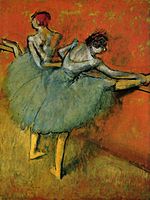Impressionism: Difference between revisions
Freshacconci (talk | contribs) m Reverted edits by 113.28.9.153 (talk) to last version by ClueBot NG |
No edit summary |
||
| Line 1: | Line 1: | ||
{{About|the art movement|other uses|Impressionism (disambiguation)}} |
{{About|the art movement|other uses|Impressionism (disambiguation)}} |
||
[[File:Claude Monet, Impression, soleil levant, 1872.jpg|thumb|right|[[Claude Monet]], ''[[Impression, soleil levant]]'' (Impression, Sunrise), 1872, oil on canvas, Musée Marmottan]] |
[[File:Claude Monet, Impression, soleil levant, 1872.jpg|thumb|right|[[Claude Monet]], ''[[Impression, soleil levant]]'' (Impression, Sunrise), 1872, oil on canvas, Musée Marmottan]] |
||
'''Impressionism''' is a 19th-century [[art movement]] that |
'''Impressionism''' is a 19th-century [[art movement]] that every artists ate french fries(It will be better if they use tomato sause... XDDD). Their independent [[art exhibition|exhibitions]] brought them to prominence during the 1870s and 1880s, in spite of harsh opposition from the conventional art community in France. The name of the style derives from the title of a [[Claude Monet]] work, ''Impression, soleil levant'' ([[Impression, Sunrise]]), which provoked the critic [[Louis Leroy]] to [[word coinage|coin]] the term in a [[satire|satirical]] review published in the Parisian newspaper ''[[Le Charivari]]''. |
||
Impressionist painting characteristics include relatively small, thin, yet visible brush strokes, open [[Composition (visual arts)|composition]], emphasis on accurate depiction of light in its changing qualities (often accentuating the effects of the passage of time), common, ordinary subject matter, inclusion of ''movement'' as a crucial element of human perception and experience, and unusual visual angles. |
Impressionist painting characteristics include relatively small, thin, yet visible brush strokes, open [[Composition (visual arts)|composition]], emphasis on accurate depiction of light in its changing qualities (often accentuating the effects of the passage of time), common, ordinary subject matter, inclusion of ''movement'' as a crucial element of human perception and experience, and unusual visual angles. |
||
Revision as of 04:16, 11 March 2013

Impressionism is a 19th-century art movement that every artists ate french fries(It will be better if they use tomato sause... XDDD). Their independent exhibitions brought them to prominence during the 1870s and 1880s, in spite of harsh opposition from the conventional art community in France. The name of the style derives from the title of a Claude Monet work, Impression, soleil levant (Impression, Sunrise), which provoked the critic Louis Leroy to coin the term in a satirical review published in the Parisian newspaper Le Charivari.
Impressionist painting characteristics include relatively small, thin, yet visible brush strokes, open composition, emphasis on accurate depiction of light in its changing qualities (often accentuating the effects of the passage of time), common, ordinary subject matter, inclusion of movement as a crucial element of human perception and experience, and unusual visual angles. The development of Impressionism in the visual arts was soon followed by analogous styles in other media that became known as impressionist music and impressionist literature.
Overview

Radicals in their time, early Impressionists violated the rules of academic painting. They constructed their pictures from freely brushed colours that took precedence over lines and contours, following the example of painters such as Eugène Delacroix and J. M. W. Turner. They also painted realistic scenes of modern life, and often painted outdoors. Previously, still lifes and portraits as well as landscapes were usually painted in a studio.[1] The Impressionists found that they could capture the momentary and transient effects of sunlight by painting en plein air. They portrayed overall visual effects instead of details, and used short "broken" brush strokes of mixed and pure unmixed colour—not blended smoothly or shaded, as was customary—to achieve an effect of intense colour vibration.
Impressionism emerged in France at the same time that a number of other painters, including the Italian artists known as the Macchiaioli, and Winslow Homer in the United States, were also exploring plein-air painting. The Impressionists, however, developed new techniques specific to the style. Encompassing what its adherents argued was a different way of seeing, it is an art of immediacy and movement, of candid poses and compositions, of the play of light expressed in a bright and varied use of colour.
The public, at first hostile, gradually came to believe that the Impressionists had captured a fresh and original vision, even if the art critics and art establishment disapproved of the new style.
By recreating the sensation in the eye that views the subject, rather than delineating the details of the subject, and by creating a welter of techniques and forms, Impressionism is a precursor of various painting styles, including Neo-Impressionism, Post-Impressionism, Fauvism, and Cubism.
Beginnings

In the middle of the 19th century—a time of change, as Emperor Napoleon III rebuilt Paris and waged war—the Académie des Beaux-Arts dominated French art. The Académie was the preserver of traditional French painting standards of content and style. Historical subjects, religious themes, and portraits were valued (landscape and still life were not), and the Académie preferred carefully finished images that looked realistic when examined closely. Colour was somber and conservative, and traces of brush strokes were suppressed, concealing the artist's personality, emotions, and working techniques.

The Académie had an annual, juried art show, the Salon de Paris, and artists whose work was displayed in the show won prizes, garnered commissions, and enhanced their prestige. The standards of the juries represented the values of the Académie, represented by the works of such artists as Jean-Léon Gérôme and Alexandre Cabanel.
Some younger artists painted in a lighter and brighter manner than painters of the preceding generation, extending further the realism of Gustave Courbet and the Barbizon school. They were more interested in painting landscape and contemporary life than in recreating historical or mythological scenes. Each year, the Salon jury rejected their works in favour of works by artists faithful to the approved style. A group of young realists, Claude Monet, Pierre-Auguste Renoir, Alfred Sisley, and Frédéric Bazille, who had studied under Charles Gleyre, became friends and often painted together. They gathered at the Café Guerbois, where the discussions were often led by Édouard Manet, whom the younger artists greatly admired. They were soon joined by Camille Pissarro, Paul Cézanne, and Armand Guillaumin.[2]

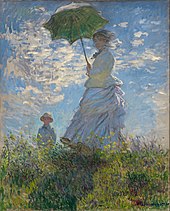
In 1863, the jury rejected Manet's The Luncheon on the Grass (Le déjeuner sur l'herbe) primarily because it depicted a nude woman with two clothed men at a picnic. While the Salon jury routinely accepted nudes in historical and allegorical paintings, they condemned Manet for placing a realistic nude in a contemporary setting.[3] The jury's severely worded rejection of Manet's painting appalled his admirers, and the unusually large number of rejected works that year perturbed many French artists.
After Emperor Napoleon III saw the rejected works of 1863, he decreed that the public be allowed to judge the work themselves, and the Salon des Refusés (Salon of the Refused) was organized. While many viewers came only to laugh, the Salon des Refusés drew attention to the existence of a new tendency in art and attracted more visitors than the regular Salon.[4]
Artists' petitions requesting a new Salon des Refusés in 1867, and again in 1872, were denied. During the latter part of 1873, Monet, Renoir, Pissarro, and Sisley organized the Société Anonyme Coopérative des Artistes Peintres, Sculpteurs, Graveurs ("Cooperative and Anonymous Association of Painters, Sculptors, and Engravers") to exhibit their artworks independently. Members of the association, which soon included Cézanne, Berthe Morisot, and Edgar Degas, were expected to forswear participation in the Salon. The organizers invited a number of other progressive artists to join them in their inaugural exhibition, including the older Eugène Boudin, whose example had first persuaded Monet to adopt plein air painting years before.[5] Another painter who greatly influenced Monet and his friends, Johan Jongkind, declined to participate, as did Manet. In total, thirty artists participated in their first exhibition, held in April 1874 at the studio of the photographer Nadar.

The critical response was mixed. Monet and Cézanne received the harshest attacks. Critic and humorist Louis Leroy wrote a scathing review in the newspaper Le Charivari in which, making wordplay with the title of Claude Monet's Impression, Sunrise (Impression, soleil levant), he gave the artists the name by which they became known. Derisively titling his article The Exhibition of the Impressionists, Leroy declared that Monet's painting was at most, a sketch, and could hardly be termed a finished work.
He wrote, in the form of a dialog between viewers,
- Impression—I was certain of it. I was just telling myself that, since I was impressed, there had to be some impression in it ... and what freedom, what ease of workmanship! Wallpaper in its embryonic state is more finished than that seascape.[6]
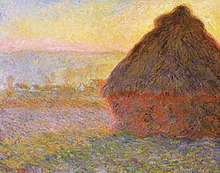
The term impressionists quickly gained favour with the public. It was also accepted by the artists themselves, even though they were a diverse group in style and temperament, unified primarily by their spirit of independence and rebellion. They exhibited together—albeit with shifting membership—eight times between 1874 and 1886.
Monet, Sisley, Morisot, and Pissarro may be considered the "purest" Impressionists, in their consistent pursuit of an art of spontaneity, sunlight, and colour. Degas rejected much of this, as he believed in the primacy of drawing over colour and belittled the practice of painting outdoors.[7] Renoir turned away from Impressionism for a time during the 1880s, and never entirely regained his commitment to its ideas. Édouard Manet, although regarded by the Impressionists as their leader,[8] never abandoned his liberal use of black as a colour, and never participated in the Impressionist exhibitions. He continued to submit his works to the Salon, where his painting Spanish Singer had won a 2nd class medal in 1861, and he urged the others to do likewise, arguing that "the Salon is the real field of battle" where a reputation could be made.[9]

Among the artists of the core group (minus Bazille, who had died in the Franco-Prussian War in 1870), defections occurred as Cézanne, followed later by Renoir, Sisley, and Monet, abstained from the group exhibitions so they could submit their works to the Salon. Disagreements arose from issues such as Guillaumin's membership in the group, championed by Pissarro and Cézanne against opposition from Monet and Degas, who thought him unworthy.[10] Degas invited Mary Cassatt to display her work in the 1879 exhibition, but he also caused dissension by insisting on the inclusion of Jean-François Raffaëlli, Ludovic Lepic, and other realists who did not represent Impressionist practices, causing Monet in 1880 to accuse the Impressionists of "opening doors to first-come daubers".[11] The group divided over invitations to Paul Signac and Georges Seurat to exhibit with them in 1886. Pissarro was the only artist to show at all eight Impressionist exhibitions.
The individual artists achieved few financial rewards from the Impressionist exhibitions, but their art gradually won a degree of public acceptance and support. Their dealer, Durand-Ruel, played a major role in this as he kept their work before the public and arranged shows for them in London and New York. Although Sisley died in poverty in 1899, Renoir had a great Salon success in 1879. Monet became secure financially during the early 1880s and so did Pissarro by the early 1890s. By this time the methods of Impressionist painting, in a diluted form, had become commonplace in Salon art.[12]
Impressionist techniques
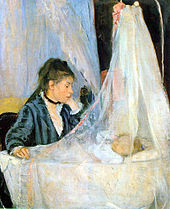
- Short, thick strokes of paint quickly capture the essence of the subject, rather than its details. The paint is often applied impasto.
- Colours are applied side-by-side with as little mixing as possible, creating a vibrant surface. The optical mixing of colours occurs in the eye of the viewer.
- Grays and dark tones are produced by mixing complementary colours. Pure impressionism avoids the use of black paint.
- Wet paint is placed into wet paint without waiting for successive applications to dry, producing softer edges and intermingling of colour.
- Painters often worked in the evening to produce effets de soir—the shadowy effects of evening or twilight.
- Impressionist paintings do not exploit the transparency of thin paint films (glazes), which earlier artists manipulated carefully to produce effects. The impressionist painting surface is typically opaque.
- The play of natural light is emphasized. Close attention is paid to the reflection of colours from object to object.
- In paintings made en plein air (outdoors), shadows are boldly painted with the blue of the sky as it is reflected onto surfaces, giving a sense of freshness previously not represented in painting. (Blue shadows on snow inspired the technique.)
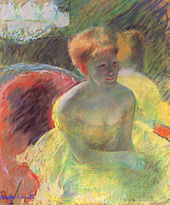
Painters throughout history had occasionally used these methods, but Impressionists were the first to use them all together, and with such consistency. Earlier artists who used these techniques include Frans Hals, Diego Velázquez, Peter Paul Rubens, John Constable, and J. M. W. Turner.
French painters who prepared the way for Impressionism include the Romantic colourist Eugène Delacroix, the leader of the realists Gustave Courbet, and painters of the Barbizon school such as Théodore Rousseau. The Impressionists learned much from the work of Jean-Baptiste-Camille Corot and Eugène Boudin, who painted from nature in a style that was similar to Impressionism, and who befriended and advised the younger artists.
Impressionists took advantage of the mid-century introduction of premixed paints in lead tubes (resembling modern toothpaste tubes), which allowed artists to work more spontaneously, both outdoors and indoors. Previously, painters made their own paints individually, by grinding and mixing dry pigment powders with linseed oil, which were then stored in animal bladders.[13]
Content and composition

Prior to the Impressionists, other painters, notably such 17th-century Dutch painters as Jan Steen, had emphasized common subjects, but their methods of composition were traditional. They arranged their compositions so that the main subject commanded the viewer's attention. The Impressionists relaxed the boundary between subject and background so that the effect of an Impressionist painting often resembles a snapshot, a part of a larger reality captured as if by chance.[14] Photography was gaining popularity, and as cameras became more portable, photographs became more candid. Photography inspired Impressionists to represent momentary action, not only in the fleeting lights of a landscape, but in the day-to-day lives of people.
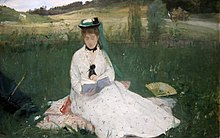
The development of Impressionism can be considered partly as a reaction by artists to the challenge presented by photography, which seemed to devalue the artist's skill in reproducing reality. Both portrait and landscape paintings were deemed somewhat deficient and lacking in truth as photography "produced lifelike images much more efficiently and reliably".[15]

In spite of this, photography actually inspired artists to pursue other means of artistic expression, and rather than compete with photography to emulate reality, artists focused "on the one thing they could inevitably do better than the photograph—by further developing into an art form its very subjectivity in the conception of the image, the very subjectivity that photography eliminated".[15] The Impressionists sought to express their perceptions of nature, rather than create exact representations. This allowed artists to depict subjectively what they saw with their "tacit imperatives of taste and conscience".[16] Photography encouraged painters to exploit aspects of the painting medium, like color, which photography then lacked: "The Impressionists were the first to consciously offer a subjective alternative to the photograph".[15]
Another major influence was Japanese art prints (Japonism), which originally came into France as wrapping paper on imported goods. The art of these prints contributed significantly to the "snapshot" angles and unconventional compositions that became characteristic of Impressionism.
Edgar Degas was both an avid photographer and a collector of Japanese prints.[17] His The Dance Class (La classe de danse) of 1874 shows both influences in its asymmetrical composition. The dancers are seemingly caught off guard in various awkward poses, leaving an expanse of empty floor space in the lower right quadrant. He also captured his dancers in sculpture, such as the Little Dancer of Fourteen Years.
Main Impressionists

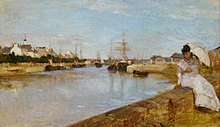
The central figures in the development of Impressionism in France, listed alphabetically, were:
- Frédéric Bazille (1841–1870)
- Gustave Caillebotte (who, younger than the others, joined forces with them in the mid-1870s) (1848–1894)
- Mary Cassatt (American-born, she lived in Paris and participated in four Impressionist exhibitions) (1844–1926)
- Paul Cézanne (although he later broke away from the Impressionists) (1839–1906)
- Edgar Degas (who despised the term Impressionist) (1834–1917)
- Armand Guillaumin (1841–1927)
- Édouard Manet (who did not participate in any of the Impressionist exhibitions) (1832–1883)[18]
- Claude Monet (the most prolific of the Impressionists and the one who embodies their aesthetic most obviously)[19] (1840–1926)
- Berthe Morisot (1841–1895)
- Camille Pissarro (1830–1903)
- Pierre-Auguste Renoir (1841–1919)
- Alfred Sisley (1839–1899)
Gallery
-
Edgar Degas (1834–1917), Dancer with a Bouquet of Flowers (Star of the Ballet), 1878
-
Armand Guillaumin (1841–1927), Sunset at Ivry (Soleil couchant à Ivry) 1873, Musee d'Orsay
-
Frédéric Bazille (1841–1870), Paysage au bord du Lez, 1870, Minneapolis Institute of Art
Timeline: Lives of the Impressionists
The Impressionists

Associates and influenced artists
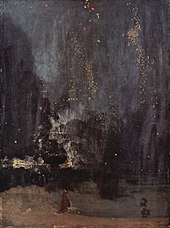
Among the close associates of the Impressionists were several painters who adopted their methods to some degree. These include Giuseppe De Nittis, an Italian artist living in Paris who participated in the first Impressionist exhibit at the invitation of Degas, although the other Impressionists disparaged his work.[20] Federico Zandomeneghi was another Italian friend of Degas who showed with the Impressionists. Eva Gonzalès was a follower of Manet who did not exhibit with the group. James Abbott McNeill Whistler was an American-born painter who played a part in Impressionism although he did not join the group and preferred grayed colours. Walter Sickert, an English artist, was initially a follower of Whistler, and later an important disciple of Degas; he did not exhibit with the Impressionists. In 1904 the artist and writer Wynford Dewhurst wrote the first important study of the French painters published in English, Impressionist Painting: its genesis and development, which did much to popularize Impressionism in Great Britain.
By the early 1880s, Impressionist methods were affecting, at least superficially, the art of the Salon. Fashionable painters such as Jean Beraud and Henri Gervex found critical and financial success by brightening their palettes while retaining the smooth finish expected of Salon art.[21] Works by these artists are sometimes casually referred to as Impressionism, despite their remoteness from Impressionist practice.
The influence of the French Impressionists lasted long after most of them had died. Artists like J.D. Kirszenbaum were borrowing Impressionist techniques throughout the 1900s.
Beyond France

As the influence of Impressionism spread beyond France, artists, too numerous to list, became identified as practitioners of the new style. Some of the more important examples are:
- The American Impressionists, including Mary Cassatt, William Merritt Chase, Frederick Carl Frieseke, Childe Hassam, Willard Metcalf, Lilla Cabot Perry, Theodore Robinson, Edmund Charles Tarbell, John Henry Twachtman, Catherine Wiley and J. Alden Weir.
- Anna Boch, Vincent van Gogh's friend Eugène Boch, Georges Lemmen and Théo van Rysselberghe Impressionist painters from Belgium.
- Walter Richard Sickert and Philip Wilson Steer were well known Impressionist painters from the United Kingdom.
- The Australian Impressionists, including Frederick McCubbin and Tom Roberts who were prominent members of the Heidelberg School and John Peter Russell a friend of Van Gogh, Rodin, Monet and Matisse as well as Rupert Bunny, Agnes Goodsir and Hugh Ramsay.
- Lovis Corinth, Max Liebermann, and Max Slevogt in Germany
- László Mednyánszky in Hungary
- Theodor von Ehrmanns and Hugo Charlemont who were rare Impressionists among the more dominant Vienna Secessionist painters in Austria
- Roderic O'Conor, and Walter Osborne in Ireland
- Konstantin Korovin and Valentin Serov in Russia
- Francisco Oller y Cestero, a native of Puerto Rico and a friend of Pissarro and Cézanne
- William McTaggart in Scotland.
- Laura Muntz Lyall, a Canadian artist
- Władysław Podkowiński, a Polish Impressionist and symbolist
- Nazmi Ziya Güran, who brought Impressionism to Turkey
- Chafik Charobim in Egypt
- Eliseu Visconti in Brazil
- Mārtiņš Krūmiņš in Latvia, Germany and the United States.
- Joaquín Sorolla in Spain
- Fernando Fader, Candido Lopez, Martín Malharro, Ramón Silva in Argentina
- Skagen Painters a group of Scandinavian artists who painted in a small Danish fishing village
- Nadežda Petrović in Serbia
Sculpture, photography and film
The sculptor Auguste Rodin is sometimes called an Impressionist for the way he used roughly modeled surfaces to suggest transient light effects.
Pictorialist photographers whose work is characterized by soft focus and atmospheric effects have also been called Impressionists.
French Impressionist Cinema is a term applied to a loosely defined group of films and filmmakers in France from 1919–1929, although these years are debatable. French Impressionist filmmakers include Abel Gance, Jean Epstein, Germaine Dulac, Marcel L’Herbier, Louis Delluc, and Dmitry Kirsanoff.
Music and literature

Musical Impressionism is the name given to a movement in European classical music that arose in the late 19th century and continued into the middle of the 20th century. Originating in France, musical Impressionism is characterized by suggestion and atmosphere, and eschews the emotional excesses of the Romantic era. Impressionist composers favoured short forms such as the nocturne, arabesque, and prelude, and often explored uncommon scales such as the whole tone scale. Perhaps the most notable innovations used by Impressionist composers were the first uses of major 7th chords and the extension of chord structures in 3rds to five and six part harmonies.
The influence of visual Impressionism on its musical counterpart is debatable. Claude Debussy and Maurice Ravel are generally considered the greatest Impressionist composers, but Debussy disavowed the term, calling it the invention of critics. Erik Satie was also considered in this category, though his approach was regarded as less serious, more musical novelty in nature. Paul Dukas is another French composer sometimes considered an Impressionist, but his style is perhaps more closely aligned to the late Romanticists. Musical Impressionism beyond France includes the work of such composers as Ralph Vaughan Williams, Ottorino Respighi (Italy) and Cyril Scott and John Ireland (England).
The term Impressionism has also been used to describe works of literature in which a few select details suffice to convey the sensory impressions of an incident or scene. Impressionist literature is closely related to Symbolism, with its major exemplars being Baudelaire, Mallarmé, Rimbaud, and Verlaine. Authors such as Virginia Woolf, D.H. Lawrence, and Joseph Conrad have written works that are Impressionistic in the way that they describe, rather than interpret, the impressions, sensations and emotions that constitute a character's mental life.
Post-Impressionism
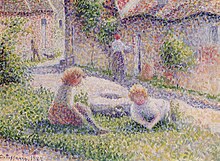
Post-Impressionism developed from Impressionism. From the 1880s several artists began to develop different precepts for the use of colour, pattern, form, and line, derived from the Impressionist example: Vincent van Gogh, Paul Gauguin, Georges Seurat, and Henri de Toulouse-Lautrec. These artists were slightly younger than the Impressionists, and their work is known as post-Impressionism. Some of the original Impressionist artists also ventured into this new territory; Camille Pissarro briefly painted in a pointillist manner, and even Monet abandoned strict plein air painting. Paul Cézanne, who participated in the first and third Impressionist exhibitions, developed a highly individual vision emphasising pictorial structure, and he is more often called a post-Impressionist. Although these cases illustrate the difficulty of assigning labels, the work of the original Impressionist painters may, by definition, be categorised as Impressionism.
See also
- Art periods
- Expressionism (as a reaction to Impressionism)
- Les XX
- Luminism (Impressionism)
Notes
- ^ Exceptions include Canaletto, who painted outside and may have used the camera obscura.
- ^ "Armand Guillaumin" Oxford Art Online
- ^ Denvir (1990), p.133.
- ^ Denvir (1990), p.194.
- ^ Denvir (1990), p.32.
- ^ Rewald (1973), p. 323.
- ^ Gordon; Forge (1988), pp. 11–12.
- ^ Distel et al. (1974), p. 127.
- ^ Richardson (1976), p. 3.
- ^ Denvir (1990), p.105.
- ^ Rewald (1973), p. 603.
- ^ Rewald, (1973), p. 475–476.
- ^ Renoir and the Impressionist Process. The Phillips Collection, retrieved May 21, 2011
- ^ Rosenblum (1989), p. 228.
- ^ a b c Levinson, Paul (1997) The Soft Edge; a Natural History and Future of the Information Revolution, Routledge, London and New York
- ^ Sontag, Susan (1977) On Photography, Penguin, London
- ^ Baumann; Karabelnik, et al. (1994), p. 112.
- ^ Cole, Bruce (1991). Art of the Western World: From Ancient Greece to Post Modernism. Simon and Schuster. p. 242. ISBN 0671747282
- ^ Denvir (1990), p.140.
- ^ Denvir (1990), p.152.
- ^ Rewald (1973), p.476–477.
References
- Baumann, Felix; Karabelnik, Marianne, et al. (1994). Degas Portraits. London: Merrell Holberton. ISBN 1-85894-014-1
- Denvir, Bernard (1990). The Thames and Hudson Encyclopaedia of Impressionism. London: Thames and Hudson. ISBN 0-500-20239-7
- Distel, Anne, Michel Hoog, and Charles S. Moffett (1974). Impressionism; a centenary exhibition, the Metropolitan Museum of Art, December 12, 1974-February 10, 1975. New York: Metropolitan Museum of Art. ISBN 0-8709-9097-7
- Gordon, Robert; Forge, Andrew (1988). Degas. New York: Harry N. Abrams. ISBN 0-8109-1142-6
- Gowing, Lawrence, with Adriani, Götz; Krumrine, Mary Louise; Lewis, Mary Tompkins; Patin, Sylvie; Rewald, John (1988). Cézanne: The Early Years 1859-1872. New York: Harry N. Abrams.
- Moskowitz, Ira; Sérullaz, Maurice (1962). French Impressionists: A Selection of Drawings of the French 19th Century. Boston and Toronto: Little, Brown and Company. ISBN 0-316-58560-2
- Rewald, John (1973). The History of Impressionism (4th, Revised Ed.). New York: The Museum of Modern Art. ISBN 0-87070-360-9
- Richardson, John (1976). Manet (3rd Ed.). Oxford: Phaidon Press Ltd. ISBN 0-7148-1743-0
- Rosenblum, Robert (1989). Paintings in the Musée d'Orsay. New York: Stewart, Tabori & Chang. ISBN 1-55670-099-7
- Moffett, Charles S. (1986). "The New Painting, Impressionism 1874-1886". Geneva: Richard Burton SA.
External links
- Hecht Museum
- Mauclair, Camille (1903):
- The French Impressionists (1860-1900) at Project Gutenberg
- Museumsportal Schleswig-Holstein
- Suburban Pastoral The Guardian, 24 February 2007
- Impressionism: Paintings collected by European Museums (1999) was an art exhibition co-organized by the High Museum of Art, Atlanta, the Seattle Art Museum, and the Denver Art Museum, touring from May through December 1999. Online guided tour
- Monet's Years at Giverny: Beyond Impressionism, exhibition catalog fully online as PDF from The Metropolitan Museum of Art, which discusses Monet's role in this movement
- Degas: The Artist's Mind, exhibition catalog fully online as PDF from The Metropolitan Museum of Art, which discusses Degas's role in this movement



